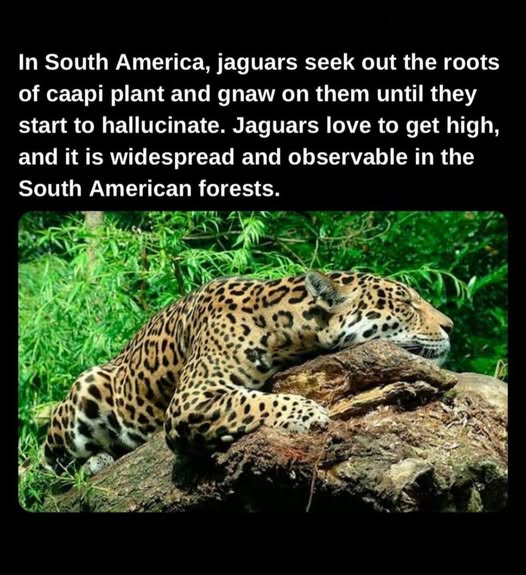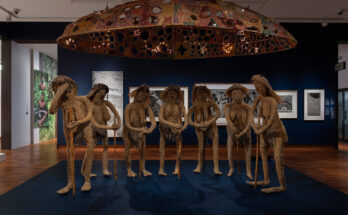Deep within the shadowy heart of the South American rainforest, where mist clings to towering canopies and rivers whisper ancient songs, an extraordinary ritual unfolds—one that blurs the lines between instinct, spirit, and mystery. Here, amid the vines and tangled roots, the mighty jaguar, apex predator and symbol of the jungle’s raw power, engages in a curious and mesmerizing behavior: it seeks out the caapi vine.
The caapi vine, known to botanists as Banisteriopsis caapi, is no ordinary plant. It is the sacred foundation of ayahuasca, the potent hallucinogenic brew used for centuries by indigenous shamans to access visions, heal the sick, and commune with the spirit world. Yet long before humans began crafting sacred potions, the jaguars found their own relationship with this mystical vine.

Observers have reported jaguars deliberately sniffing out the caapi roots, chewing or gnawing at the thick vines, and then slipping into trance-like states. Their pupils dilate to black moons. Their muscles loosen. Movements that were once sleek and calculated become slow, fluid, almost dreamlike. It’s as if the jungle’s fiercest hunter has stepped sideways into another realm.
This behavior is not an isolated anomaly. It has been observed across wide stretches of jaguar territory, from the Peruvian Amazon to the dense forests of Brazil. Scientists have confirmed that this interaction is purposeful and repeated, suggesting that jaguars are drawn back to the caapi vine time and again—not by accident, but by deep instinct or inner need.
Why would a supreme predator, with no rivals and few threats, deliberately seek out a hallucinogenic plant?
Theories abound.
Some researchers propose that jaguars may be self-medicating. Many animals are known to consume specific plants to treat infections, expel parasites, or aid digestion—a practice known as zoopharmacognosy. It’s possible that the alkaloids in the caapi vine have some health benefit for the jaguar, strengthening its body or clearing unseen ailments.
Others suggest a more thrilling idea: that jaguars use the caapi vine for sensory enhancement. Ayahuasca, after all, is not just a hallucinogen; it profoundly alters perception, sharpening some senses while distorting others. A jaguar under the influence might experience heightened hearing, intensified smells, or a sharpened focus—powerful advantages for a solitary hunter navigating the dense, deceptive world of the rainforest.
But in the traditions of indigenous Amazonian cultures, the explanation goes even deeper. For the tribes who have lived alongside these cats for millennia, the jaguar is not merely an animal; it is a spirit guide, a being that walks between worlds. Shamans often invoke the jaguar’s spirit during ceremonies, seeking its strength, its courage, and its access to hidden realms. The fact that jaguars themselves seek the caapi vine only confirms their special status. To the peoples of the Amazon, this isn’t just biology—it’s sacred communion.
Perhaps the jaguars aren’t just chasing chemical thrills or medicinal cures. Perhaps they, like the shamans, are reaching out—pushing beyond the physical into the vast unknown that hums beneath the green skin of the forest.
Whatever the reason, the image is unforgettable: a creature born of muscle and fang, pausing its endless quest for survival to surrender itself to a plant’s strange power. In doing so, it reminds us that even in nature, even among predators that seem invincible, there is room for mystery, for altered states, for the pursuit of something more than mere survival.
In the jungle, survival is only part of life. There is also exploration. There is wonder.
And sometimes, even the fiercest must pause to chase not prey—but visions.


